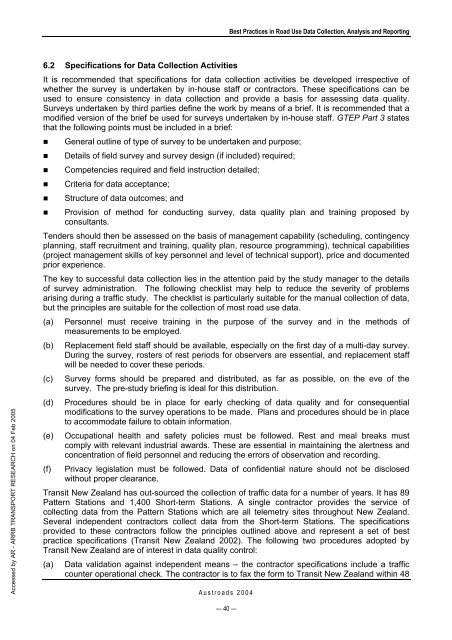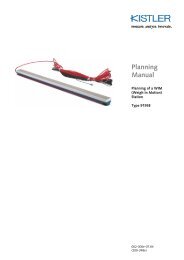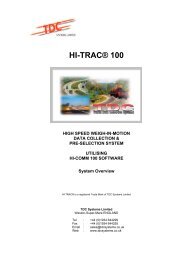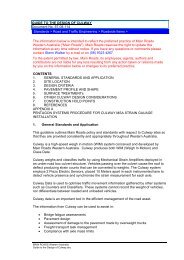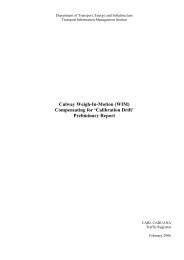AP-G84/04 Best practice in road use data collection, analysis ... - WIM
AP-G84/04 Best practice in road use data collection, analysis ... - WIM
AP-G84/04 Best practice in road use data collection, analysis ... - WIM
You also want an ePaper? Increase the reach of your titles
YUMPU automatically turns print PDFs into web optimized ePapers that Google loves.
Accessed by AR - ARRB TRANSPORT RESEARCH on <strong>04</strong> Feb 2005<br />
Aust<strong>road</strong>s 20<strong>04</strong><br />
— 40 —<br />
<strong>Best</strong> Practices <strong>in</strong> Road Use Data Collection, Analysis and Report<strong>in</strong>g<br />
6.2 Specifications for Data Collection Activities<br />
It is recommended that specifications for <strong>data</strong> <strong>collection</strong> activities be developed irrespective of<br />
whether the survey is undertaken by <strong>in</strong>-ho<strong>use</strong> staff or contractors. These specifications can be<br />
<strong>use</strong>d to ensure consistency <strong>in</strong> <strong>data</strong> <strong>collection</strong> and provide a basis for assess<strong>in</strong>g <strong>data</strong> quality.<br />
Surveys undertaken by third parties def<strong>in</strong>e the work by means of a brief. It is recommended that a<br />
modified version of the brief be <strong>use</strong>d for surveys undertaken by <strong>in</strong>-ho<strong>use</strong> staff. GTEP Part 3 states<br />
that the follow<strong>in</strong>g po<strong>in</strong>ts must be <strong>in</strong>cluded <strong>in</strong> a brief:<br />
General outl<strong>in</strong>e of type of survey to be undertaken and purpose;<br />
Details of field survey and survey design (if <strong>in</strong>cluded) required;<br />
Competencies required and field <strong>in</strong>struction detailed;<br />
Criteria for <strong>data</strong> acceptance;<br />
Structure of <strong>data</strong> outcomes; and<br />
Provision of method for conduct<strong>in</strong>g survey, <strong>data</strong> quality plan and tra<strong>in</strong><strong>in</strong>g proposed by<br />
consultants.<br />
Tenders should then be assessed on the basis of management capability (schedul<strong>in</strong>g, cont<strong>in</strong>gency<br />
plann<strong>in</strong>g, staff recruitment and tra<strong>in</strong><strong>in</strong>g, quality plan, resource programm<strong>in</strong>g), technical capabilities<br />
(project management skills of key personnel and level of technical support), price and documented<br />
prior experience.<br />
The key to successful <strong>data</strong> <strong>collection</strong> lies <strong>in</strong> the attention paid by the study manager to the details<br />
of survey adm<strong>in</strong>istration. The follow<strong>in</strong>g checklist may help to reduce the severity of problems<br />
aris<strong>in</strong>g dur<strong>in</strong>g a traffic study. The checklist is particularly suitable for the manual <strong>collection</strong> of <strong>data</strong>,<br />
but the pr<strong>in</strong>ciples are suitable for the <strong>collection</strong> of most <strong>road</strong> <strong>use</strong> <strong>data</strong>.<br />
(a) Personnel must receive tra<strong>in</strong><strong>in</strong>g <strong>in</strong> the purpose of the survey and <strong>in</strong> the methods of<br />
measurements to be employed.<br />
(b) Replacement field staff should be available, especially on the first day of a multi-day survey.<br />
Dur<strong>in</strong>g the survey, rosters of rest periods for observers are essential, and replacement staff<br />
will be needed to cover these periods.<br />
(c) Survey forms should be prepared and distributed, as far as possible, on the eve of the<br />
survey. The pre-study brief<strong>in</strong>g is ideal for this distribution.<br />
(d) Procedures should be <strong>in</strong> place for early check<strong>in</strong>g of <strong>data</strong> quality and for consequential<br />
modifications to the survey operations to be made. Plans and procedures should be <strong>in</strong> place<br />
to accommodate failure to obta<strong>in</strong> <strong>in</strong>formation.<br />
(e) Occupational health and safety policies must be followed. Rest and meal breaks must<br />
comply with relevant <strong>in</strong>dustrial awards. These are essential <strong>in</strong> ma<strong>in</strong>ta<strong>in</strong><strong>in</strong>g the alertness and<br />
concentration of field personnel and reduc<strong>in</strong>g the errors of observation and record<strong>in</strong>g.<br />
(f) Privacy legislation must be followed. Data of confidential nature should not be disclosed<br />
without proper clearance.<br />
Transit New Zealand has out-sourced the <strong>collection</strong> of traffic <strong>data</strong> for a number of years. It has 89<br />
Pattern Stations and 1,400 Short-term Stations. A s<strong>in</strong>gle contractor provides the service of<br />
collect<strong>in</strong>g <strong>data</strong> from the Pattern Stations which are all telemetry sites throughout New Zealand.<br />
Several <strong>in</strong>dependent contractors collect <strong>data</strong> from the Short-term Stations. The specifications<br />
provided to these contractors follow the pr<strong>in</strong>ciples outl<strong>in</strong>ed above and represent a set of best<br />
<strong>practice</strong> specifications (Transit New Zealand 2002). The follow<strong>in</strong>g two procedures adopted by<br />
Transit New Zealand are of <strong>in</strong>terest <strong>in</strong> <strong>data</strong> quality control:<br />
(a) Data validation aga<strong>in</strong>st <strong>in</strong>dependent means – the contractor specifications <strong>in</strong>clude a traffic<br />
counter operational check. The contractor is to fax the form to Transit New Zealand with<strong>in</strong> 48


